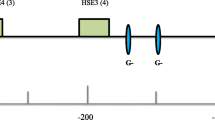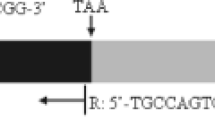Abstract
To investigate the genetic basis of differing thermotolerance in the closely related species Drosophila virilis and Drosophila lummei, which replace one another along a latitudinal cline, we characterized the hsp70 gene cluster in multiple strains of both species. In both species, all hsp70 copies cluster in a single chromosomal locus, 29C1, and each cluster includes two hsp70 genes arranged as an inverted pair, the ancestral condition. The total number of hsp70 copies is maximally seven in the more thermotolerant D. virilis and five in the less tolerant D. lummei, with some strains of each species exhibiting lower copy numbers. Thus, maximum hsp70 copy number corresponds to hsp70 mRNA and Hsp70 protein levels reported previously and the size of heat-induced puffs at 29C1. The nucleotide sequence and spacing of the hsp70 copies are consistent with tandem duplication of the hsp70 genes in a common ancestor of D. virilis and D. lummei followed by loss of hsp70 genes in D. lummei. These and other data for hsp70 in Drosophila suggest that evolutionary adaptation has repeatedly modified hsp70 copy number by several different genetic mechanisms.





Similar content being viewed by others
References
Ashburner M (1989) Drosophila. Cold Spring Harbor Laboratory, Cold Spring Harbor
Benedict MQ, Cockburn AF, Seawright JA (1993) The Hsp70 heat-shock gene family of the mosquito Anopheles albimanus. Insect Mol Biol 2:93–102
Bettencourt BR, Feder ME (2001) hsp70 duplication in the Drosophila melanogaster species group: how and when did two become five? Mol Biol Evol 18:1272–1282
Bettencourt BR, Feder ME (2002) Rapid concerted evolution via gene conversion at the Drosophila hsp70 genes. J Mol Evol 54:569–586
Biessmann H, Zurovcova M, Yao J, Lozovskaya E, Walter M (2000) A telomeric satellite in Drosophila virilis and its sibling species. Chromosoma 109:372–380
Bushman F (2002) Lateral DNA transfer: mechanisms and consequences. Cold Spring Harbor Laboratory, Cold Spring Harbor
Elena SF, Lenski RE (2003) Evolution experiments with microorganisms: the dynamics and genetic bases of adaptation. Nat Rev Genet 4:457–469
Evgen’ev MB, Kolchinski A, Levin A, Preobrazhenskaya AL, Sarkisova E (1978) Heat-shock DNA homology in distantly related species of Drosophila. Chromosoma 68:357–365
Evgen’ev MB, Yenikolopov GN, Peunova NI, Ilyin YV (1982) Transposition of mobile genetic elements in interspecific hybrids of Drosophila. Chromosoma 85:375–386
Evgenev MB, Zelentsova H, Shostak N, Kozitsina M, Barskyi V, Lankenau DH, Corces VG (1997) Penelope, a new family of transposable elements and its possible role in hybrid dysgenesis in Drosophila virilis.Proc Natl Acad Sci USA 94:196-201
Evgen’ev M, Zelentsova H, Mnjoian L, Poluectova H, Kidwell MG (2000a) Invasion of Drosophila virilis by the Penelope transposable element. Chromosoma 109:350–357
Evgen’ev MB, Zelentsova H, Poluectova H, Lyozin GT, Veleikodvorskaja V, Pyatkov KI, Zhivotovsky LA, Kidwell MG (2000b) Mobile elements and chromosomal evolution in the virilis group of Drosophila. Proc Natl Acad Sci USA 97:11337–11342
Feder ME, Hofmann GE (1999) Heat-shock proteins, molecular chaperones, and the stress response: evolutionary and ecological physiology. Annu Rev Physiol 61:243–282
Feder ME, Krebs RA (1998) Natural and genetic engineering of thermotolerance in Drosophila melanogaster. Am Zool 38:503–517
Garbuz DG, Molodtsov VB, Velikodvorskaia VV, Evgen’ev MB, Zatsepina OG (2002) Evolution of the response to heat shock in genus Drosophila. Russ J Genet 38:925–936
Garbuz D, Evgen’ev MB, Feder ME, Zatsepina OG (2003) Evolution of thermotolerance and the heat-shock response: evidence from inter/intraspecific comparison and interspecific hybridization in the virilis species group of Drosophila. I. Thermal phenotype. J Exp Biol 206:2399–2408
Huey RB, Gilchrist GW, Carlson ML, Berrigan D, Serra L (2000) Rapid evolution of a geographic cline in size in an introduced fly. Science 287:308–309
Jeanmougin F, Thompson JD, Gouy M, Higgins DG, Gibson TJ (1998) Multiple sequence alignment with Clustal x. Trends Biochem Sci 23:403–405
Konstantopoulou I, Nikolaidis N, Scouras ZG (1998) The hsp70 locus of Drosophila auraria (montium subgroup) is single and contains copies in a conserved arrangement. Chromosoma 107:577–586
Leigh-Brown AJ, Ish-Horowicz D (1981) Evolution of the 87A and 87C heat-shock loci in Drosophila. Nature 290:677–682
Lerman DN, Michalak P, Helin AB, Bettencourt BR, Feder ME (2003) Modification of heat-shock gene expression in Drosophila melanogaster populations via transposable elements. Mol Biol Evol 20:135–144
Li W-H (1997) Molecular evolution. Sinauer, Sunderland
Lim JK (1993) In situ hybridization with biotinylated DNA. Dros Inf Serv 72:73–77
Lumme J (1982) The genetic basis of the photoperiodic timing of the onset of winter dormancy in Drosophila littoralis. Acta Univ Oulu 129:1–42
Maside X, Bartolome C, Charlesworth B (2002) S-element insertions are associated with the evolution of the hsp70 genes in Drosophila melanogaster. Curr Biol 12:1686–1691
McGarry TJ, Lindquist S (1985) The preferential translation of Drosophila hsp70 mRNA requires sequences in the untranslated leader. Cell 42:903–911
Mitrofanov VG, Blanter TV (1975) A study of temperature-sensitive mutations in the virilis group of Drosophila. Ontogenesis 6:386–391
Nurminsky DI, Moriyama EN, Lozovskaya ER, Hartl DL (1996) Molecular phylogeny and genome evolution in the Drosophila virilis species group: duplications of the alcohol dehydrogenase gene. Mol Biol Evol 13:132–149
Patterson JT, Stone WS (1952) Evolution in the genus Drosophila. Macmillan, New York
Peters FP, Lubsen NH, Sondermeijer PJ (1980) Rapid sequence divergence in a heat shock locus of Drosophila. Chromosoma 81:271–280
Spicer GS (1991) Molecular evolution and phylogeny of the Drosophila virilis species group as inferred by 2-dimensional electrophoresis. J Mol Evol 33:379–394
Spicer GS (1992) Reevaluation of the phylogeny of the Drosophila virilis species group (Diptera, Drosophilidae). Ann Entomol Soc Am 85:11–25
Spicer GS, Bell CD (2002) Molecular phylogeny of the Drosophila virilis species group (Diptera: Drosophilidae) inferred from mitochondrial 12S and 16S ribosomal RNA genes. Ann Entomol Soc Am 95:156–161
Thompson-Stewart D, Karpen G, Spradling A (1994) A transposable element can drive the concerted evolution of tandemly repetitious DNA. Proc Natl Acad Sci USA 91:9042–9046
Throckmorton LH (1982) The virilis species group. In: Ashburner M, Carson HL, Thompson JN (eds) The genetics and biology of drosophila, vol 3d. Academic, London, pp 227–296
Zatsepina OG et al (2001) A Drosophila melanogaster strain from sub-equatorial Africa has exceptional thermotolerance but decreased Hsp70 expression. J Exp Biol 204:1869–1881
Zelentsova ES, Vashakidze RP, Krayev AS, Evgen’ev MB (1986) Dispersed repeats in Drosophila virilis: elements mobilized by interspecific hybridization. Chromosoma 93:469–476
Zelentsova H et al (1999) Distribution and evolution of mobile elements in the virilis species group of Drosophila. Chromosoma 108:443–456
Acknowledgements
In Russia, research was supported by Russian Grants for Basic Science 0304-48-918 and 0204-49121. In Chicago, research was supported by an International Supplement to NSF grant IBN99-86158 and a Howard Hughes Medical Institute Predoctoral Fellowship. We thank Dr. G.T. Lyozin for technical assistance, Dr. Anneli Hoikkala for providing D. virilis strains, and Dr. B.R. Bettencourt for help in interpreting Drosophila pseudoobscura genomic data and comments on the manuscript.
Author information
Authors and Affiliations
Corresponding author
Additional information
Communicated by R. Paro
Rights and permissions
About this article
Cite this article
Evgen’ev, M.B., Zatsepina, O.G., Garbuz, D. et al. Evolution and arrangement of the hsp70 gene cluster in two closely related species of the virilis group of Drosophila. Chromosoma 113, 223–232 (2004). https://doi.org/10.1007/s00412-004-0312-6
Received:
Revised:
Accepted:
Published:
Issue Date:
DOI: https://doi.org/10.1007/s00412-004-0312-6




